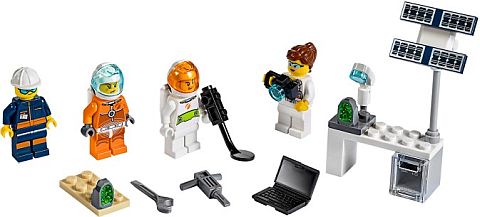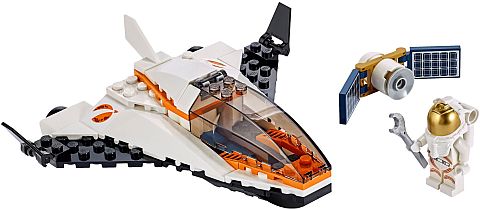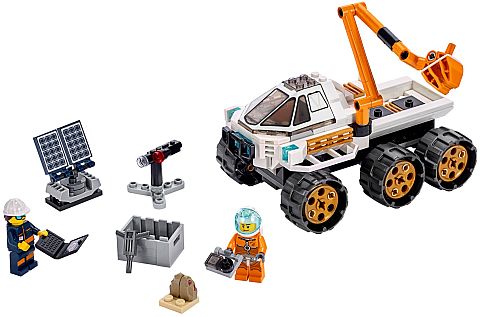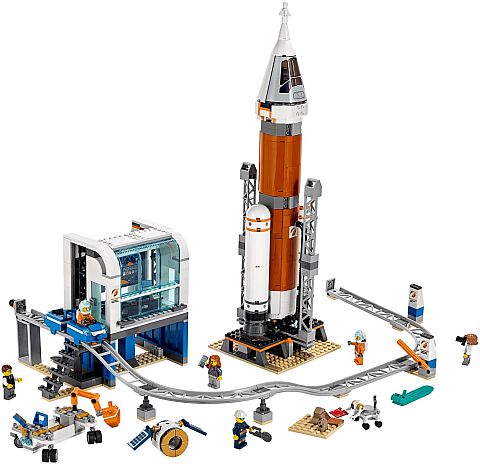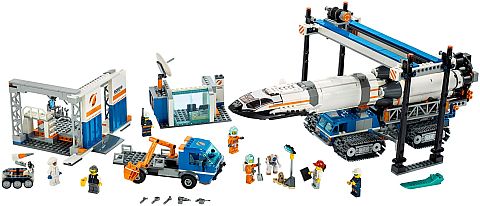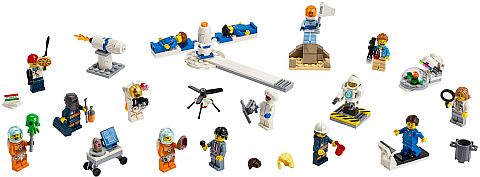As we discussed at the beginning of last month, LEGO has been releasing the 2019 summer sets gradually, with some regions getting certain themes earlier than others. In North America, the #75810 LEGO Stranger Things: The Upside Down set, the #10266 LEGO Creator NASA Apollo 11 Lunar Lander, the LEGO City Space Exploration sets, and some of the LEGO City People Packs were released last month. For the month of July, we get even more new sets, so let’s take a look.

➡ DOUBLE VIP POINTS: From July 1-7, you will get LEGO VIP members will earn Double VIP Points on all purchases at official LEGO stores and the Online LEGO Shop. And, during the whole month of July, there are two sets you can get with Double VIP Points: the #60227 LEGO City Lunar Space Station, and the #60228 LEGO City Deep Space Rocket and Launch Control. Both are excellent sets from the new LEGO City Space Exploration line that you can find at the LEGO City section of the Online LEGO Shop.

➡ LEGO JURASSIC PARK: T. REX RAMPAGE: First of all, the #75936 LEGO Jurassic Park: T. Rex Rampage set is now available to everyone not just LEGO VIP members. We talked about this set extensively (see links at the end of this post). It is available (along with other LEGO Jurassic World/Jurassic Park sets) at the Online LEGO Shop.
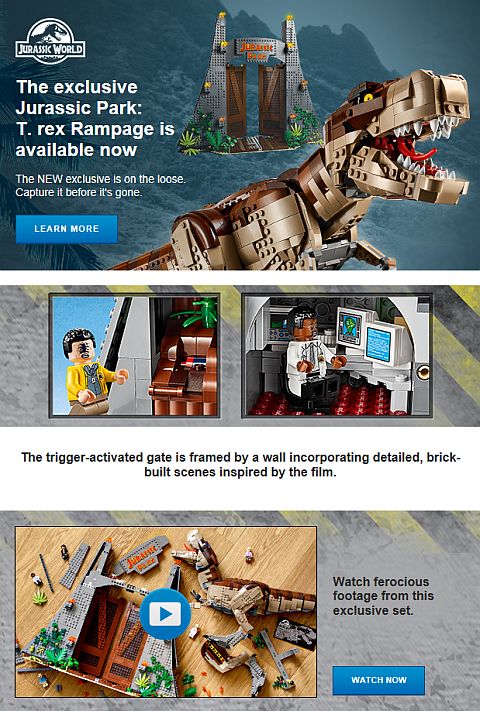
➡ 2019 LEGO JURASSIC WORLD SETS: Besides the large T. rex set, we are also getting four regular LEGO Jurassic World sets. Three of these won’t be available until August, but the #75934 LEGO Jurassic World Dilophosaurus on the Loose set is now available. You can find it (along with pictures of the other upcoming sets) at the LEGO Jurassic World section of the Online LEGO Shop.
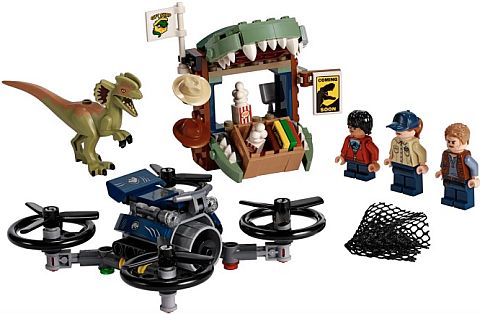
➡ 2019 LEGO HARRY POTTER SUMMER SETS: The highly anticipated LEGO Harry Potter summer sets are now available! This includes the #75945 LEGO Harry Potter Expecto Patronum, the #75946 LEGO Harry Potter Hungarian Horntail Triwizard Challenge, the #75947 LEGO Harry Potter Hagrid’s Hut: Buckbeak’s Rescue, the #75948 LEGO Harry Potter Hogwarts Clock Tower, and the #75957 LEGO Harry Potter The Knight Bus. Remember that the Clock Tower can be combined with the previously released buildings for an awesome layout! You can find all the new sets at the LEGO Harry Potter section of the Online LEGO Shop.
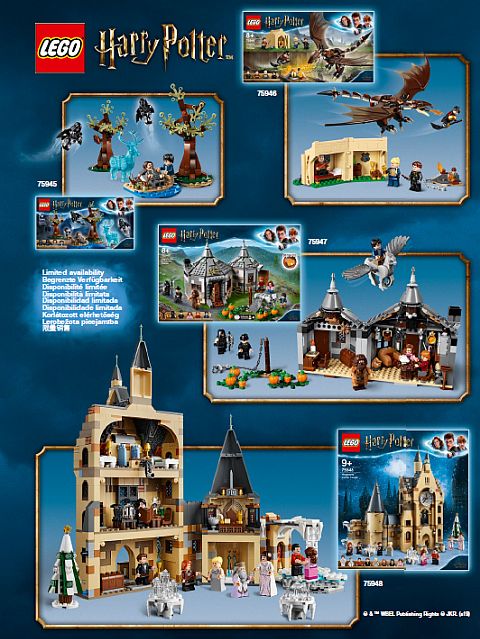
➡ LEGO STAR WARS DROID COMMANDER: The #75253 LEGO Star Wars Droid Commander set that operates with the new LEGO BOOST robotics system is now available! We talked about this set before (see links at the end of this post), but to recap, this interactive robot set puts you in command of three app-controlled LEGO Star Wars droids: R2-D2, a Gonk Droid, and a Mouse Droid, each with their own personalities and skills. Using the free LEGO BOOST Star Wars app, you can build the droids, inserts the Bluetooth-controlled Move Hub into the one that will solve each mission, and brings it to life using the intuitive drag-and-drop coding environment (visit LEGO.com/DeviceCheck for a list of compatible devices). Then, you can constructs tools, weapons, targets, obstacles and lots more as you progress through over 40 exciting missions. The set is designed for kids aged 8+ to help them develop critical thinking and creative problem-solving skills, introduce them to basic engineering and robotics, all within the Star Wars universe. The set includes a color & distance sensor, interactive motor, Move Hub, light brick, and all the pieces needed to build all three droids. (Please note that only one robot can be brought to life at a time using the included Bluetooth-controlled Move Hub.) Comes with 1,177 pieces. Price: $199.99 – BUY HERE

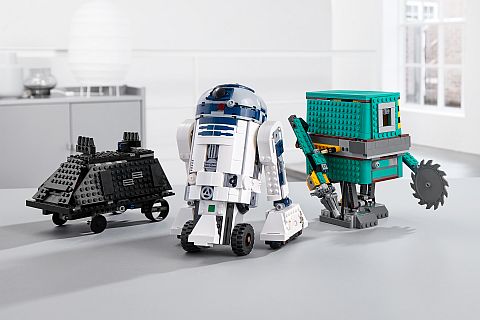
➡ LEGO CHINESE NEW YEAR SET: The #80103 LEGO Chinese New Year Dragon Boat Race is now available! This set, and two other previous Chinese New Year sets, were only available in Asia (for further info, see links at the end of this post). However, due to much uproar from the LEGO fan community, at least this third set is now listed worldwide and available at official LEGO stores and the Online LEGO Shop. The set features two awesome dragon boats, a dock with a food stall, viewing area and judge’s stand, plus buildable finishing line posts. Each boat features a dragon head with an opening mouth and posable tail, three minifigure seats for the paddlers, space for the helmsman and drummer to stand, plus small wheels underneath for racing. The set also comes with a whopping fifteen minifigures! Dock measures over 5” (13cm) high, 12” (32cm) wide and 2” (6cm) deep. Boats each measure over 1” (5cm) high, 14” (36cm) long and 1” (4cm) wide. 643 pieces. Price: $49.99 – BUY HERE

➡ LEGO CITY SPACE EXPLORATION SETS: These sets became available at the second part of last month, so I thought to mention them again in case you weren’t aware of their existence. They are some of the best LEGO Space sets we have seen for some time, and I highly recommend checking them out. We talked about them in detail a couple of days ago (see links at the end of this post), and you can find them at the LEGO City section of the Online LEGO Shop.

➡ 2019 LEGO FRIENDS SUMMER SETS: There is a large selection of LEGO Friends sets coming, including a large amusement park, several underwater and other water exploration and aquatic wildlife related sets, and a nicely designed restaurant, but sadly, most of the sets won’t be available until August. The only set that is listed for a July release is the #41376 LEGO Friends Turtles Rescue Mission. However, if you would like to plan ahead, the other upcoming sets can also be seen at the LEGO Friends section of the Online LEGO Shop.
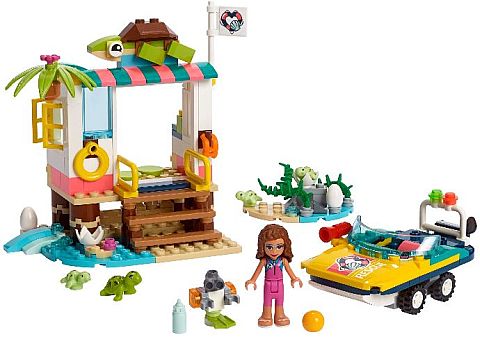
As far as promotions during the month of July, there are a couple of them worth paying attention to. Between July 12-14, LEGO is offering exclusive offers and sales. We don’t know yet what this will include, but they call it Christmas in July, so it should be good! Then, July 18-21, you can get a free #30365 LEGO City Space Satellite polybag with purchases of $40 or more. This is an especially welcome little freebie if you plan to get the new LEGO City Space sets. Check the Online LEGO Shop on those dates.

➡ LEGO SUMMER SETS IN AUGUST: Sets released in August will include the #21045 LEGO Architecture Trafalgar Square, and the #21046 LEGO Architecture Empire State Building. Amongst the regular LEGO City sets, one of the best ones is the #60233 LEGO City Donut Shop Opening. There are some great LEGO Creator sets coming as well, including a UFO-themed carousel, a lovely modular townhouse, a helicopter, and a forest hut. All these sets will come with alternate builds and can be seen already at the LEGO Creator section of the Online LEGO Shop. We are also getting six new Batman sets, rehashing some old favorites as well as new additions. You can find them at the LEGO DC Super Heroes section of the Online LEGO Shop. LEGO Ninjago is getting a large wave with some fantastic sets, and a new generation of spinners. Some of the highlights are the #70676 LEGO Ninjago Titan Mech, the #70677 LEGO Ninjago Land Bounty, and the #70678 LEGO Ninjago Castle of the Forsaken Emperor. See them all at the LEGO Ninjago section of the Online LEGO Shop.
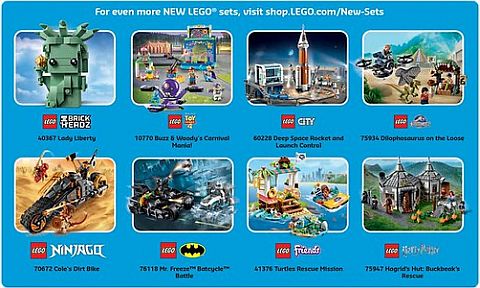
Besides the new and upcoming sets, don’t forget about some of the previous recent releases like the #75244 LEGO Star Wars Tantive IV, the second wave of the #70837 LEGO Movie 2 sets, the new LEGO Marvel Super Heroes sets, the LEGO Toy Story 4 sets, and more. You can find them all at the New tab of the Online LEGO Shop.
What do you think? How do you like the newly released sets and the other sets coming later this summer? Are you planning to get anything this month? Or are you waiting for the later releases? Which sets are your favorites? Feel free to share your thoughts and discuss in the comment section below!
And you might also like to check out the following related posts:
- Combining LEGO Harry Potter Sets & More!
- LEGO Chinese New Year Sets Video-Reviews
- LEGO Jurassic Park Set Available & Contest!
- LEGO Star Wars BOOST Coming Soon & More!
- LEGO Star Wars Tantive IV Designer-Video
- LEGO Spider-Man: Far From Home Sets Review
- LEGO Toy Story 4 Collection Review
- LEGO Stranger Things Set Available Now!
- LEGO Marvel Avengers: Endgame Sets Reviews
- LEGO Ford Mustang Designer Video & More!
- LEGO Ideas Steamboat Willie Press-Release
- LEGO Ideas The Flintstones Review & Thoughts
- 2019 LEGO Ninjago Legacy Sets Overview
- 2019 LEGO Spider-Man Sets Review
- 2019 LEGO Technic Sets Review & Thoughts
- LEGO Overwatch Sets Video-Reviews & More!
➡ LEGO SHOP IN USA: Online LEGO Shop USA
➡ LEGO SHOP IN CANADA: Online LEGO Shop Canada
➡ LEGO SHOP IN UK: Online LEGO Shop UK


